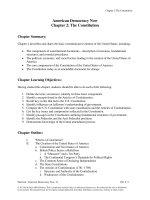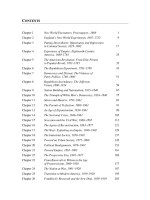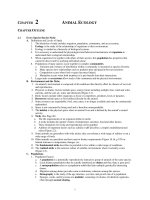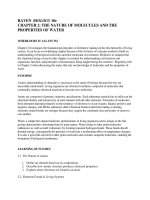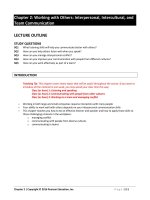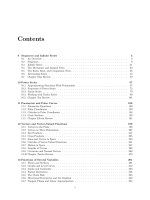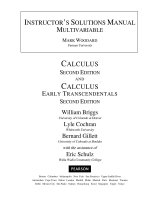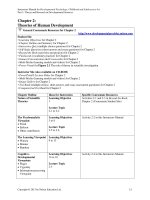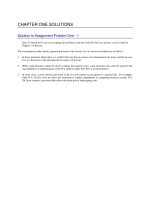Test bank and solution of business law ch02 source of the law (1)
Bạn đang xem bản rút gọn của tài liệu. Xem và tải ngay bản đầy đủ của tài liệu tại đây (252.45 KB, 10 trang )
Chapter 02 - Sources of the Law
Chapter 2
Sources of the Law
I. Key Terms
Administrative law (p. 40)
Articles of Confederation (p. 29)
Binding precedent (p. 38)
Code (p. 36)
Code of Federal Regulations
(CFR) (p. 40)
Common law (p. 38)
Constitution (p. 28)
Constitutional law (p. 28)
Cyber-commerce (p. 37)
Devolution (p. 34)
Federal Register (p. 40)
Judicial review (p. 39)
Law (p. 25)
Persuasive precedent (p. 38)
Precedent (p. 38)
Preemption (p. 34)
Statutes (p. 35)
Statutory interpretation (p. 39)
Titles (p. 36)
Uniform Commercial Code
(UCC) (p. 37)
II. Learning Objectives
1. List the objectives of the law.
2. Clarify the duality of the law.
3. Outline the content of the U.S. Constitution.
4. Explain several central constitutional principles and powers.
5. Explain the role of statutory law in the legal system.
6. Defend the need to set up a system of uniform laws.
7. State the role of common law in the legal system.
8. Describe how the principle of stare decisis provides stability within the law.
9. Differentiate between statutory interpretation and judicial review.
10. Account for the legislature’s need to establish administrative agencies.
III. Major Concepts
2-1
The Purpose and Operation of the Law
A primary objective of the law is the promotion of harmony, stability and justice;
but a balance is difficult to maintain. Dualities in the law involve the spirit versus
the letter of the law, legal words versus their interpretation, and abstract principles
versus concrete situations. Balancing also comes into play in the application of
the Uncertainty Principle involving duality in the way a decision is intended and
the way it is actually executed.
2-2
Constitutional Law
A constitution is the basic law of a nation or state. The U.S. Constitution provides
the organization of the national government. Each state also has a constitution that
determines the state’s governmental structure. The Articles of Confederation was
the first constitution of the United States. Weaknesses of the Articles of
2-1
Chapter 02 - Sources of the Law
Confederation were that the national legislature could not impose taxes, all
delegates to Congress were appointed by the state legislatures, and the states
retained the power to issue their own currency. Although the Articles of
Confederation had some strong points, its weaknesses lead to development of the
U.S. Constitution. The U.S. Constitution is based on a separation of national
powers among three branches of government, the executive, legislative, and
judicial branches; and a system of checks and balances. It is divided into two
parts, the articles and the amendments. Some would like to see the 17th
amendment granting citizens the right to directly vote for senators with an
amendment returning the process of electing senators back to state legislators
consistent with the process employed under the Articles of Confederation. In
addition to the U.S. Constitution, each state in the union adopts its own
constitution. A basic principle of constitutional law it that the U.S. Constitution is
the supreme law of the land. Preemption is the process by which courts decide
that a federal statute must take precedence over a state statute. Devolution occurs
when courts redefine a right and shift the obligation to enforce that right from an
upper level authority to a lower one. The federal government’s power to regulate
business has emerged over the years out of the Commerce Clause of the U.S.
Constitution. The federal government can regulate any business activity that
affects interstate commerce, even if the activity takes place solely within the
borders of a single state. The First Amendment contains important rights
including freedom of the press, freedom of speech, freedom of assembly, and
freedom of religion. Freedom of speech is a source of controversy because, for
example, individual rights must be balanced with the rights of others.
2-3
Statutory Law
The laws passed by a legislature are known as statutes. At the federal level
statutes are the laws made by Congress and signed by the President. At the state
level, statutes are enacted by state legislatures. Statutes must be arranged,
cataloged, and indexed for easy reference. That is done by compiling state and
federal codes. A code is a compilation of all the statutes of a particular state or of
the federal government. Because many different statutes are passed each year by
the fifty state legislatures, there are important differences in state statutory law
throughout the nation. One solution to the problem of inconsistent statutory law is
for the legislatures of all the states to adopt the same statutes. The National
Conference of Commissioners on Uniform State Laws (NCCUSL) was founded to
write those uniform laws. A uniform law does not become a binding statute until
it has been officially passed by a state legislature. The Uniform Commercial Code
(UCC) is a unified set of statutes designated to govern almost all commercial
transactions. The advent of the Information Age resulted in a need for specific
electronic law statutes. The Uniform Computer Information Transaction Act and
the Uniform Electronic Transactions Act are two uniform laws recently approved
by the NCCUSL for adoption by state legislatures.
2-2
Chapter 02 - Sources of the Law
2-4
Court Decisions
Courts make law through common law, the interpretation of statutes, and by
judicial review. Common law is the body of previously recorded legal decisions
made by the courts in specific cases. The process of relying on previously
recorded legal decisions is called stare decisis (let the decision stand). The legal
system of the U.S., except Louisiana, is rooted in the common law of England.
Judges rely on precedent which is a model case that a court can follow when
facing a similar situation. A second way that courts make law is through the
interpretation of statutes. A third way that courts make law is through judicial
review which is the process of determining the constitutionality of various
legislative statutes, administrative regulations, or executive actions. Ultimate
authority on such issues rests with the U.S. Supreme Court.
2-5
Administrative Regulations
Federal administrative agencies administer statutes enacted by Congress in
specific areas. Agencies have also been designated by the states to supervise
intrastate activities. Agencies create rules, regulate and supervise, and render
decisions. Decrees and decisions of agencies are known as administrative law.
Congress passed the federal Administrative Procedures Act to regulate federal
agencies. Most states have adopted the Model State Administrative Procedures
Act to regulate state agencies. Those acts allow for notification of affected parties,
hearings, and judicial review. The Federal Register produces a daily compilation
of new regulations issued by federal administrative agencies as well as proposed
rules and notices. Once a rule is finalized, it is included in the Code of Federal
Regulations.
IV. Outline
I. The Purpose and Operation of the Law (2-1)
A. The Law as a Balancing Act
1. The law is often a balancing act.
2. Generally, the objectives of order, stability and justice are kept in mind; but
the law is not perfect.
B. The Dualities within the Law
1. Balancing is part of the law’s fundamental nature.
2. The legal system is shaped by several dualities.
a. The spirit versus the letter of the law is an obvious duality.
b. The written word versus its interpretation is a duality addressing
ambiguity.
c. The abstract versus the concrete involves application of a principle to a
concrete issue.
d. The uncertainty principle involves duality between the way a decision is
intended and the way it is actually executed.
2-3
Chapter 02 - Sources of the Law
II. Constitutional Law (2-2)
A. The Articles of Confederation
1. The first constitution was known as the Articles of Confederation.
2. The Articles of Confederation had certain weaknesses.
a. The Congress could not impose taxes.
b. All delegates to Congress were appointed by state legislatures.
c. The states retained the power to issue their own currency.
3. The Articles had some strong points.
a. Members of Congress were provided some protections.
b. The document contained a full faith and credit clause.
c. Terms of congressional delegates and the president were limited.
B. The Principles of the United States Constitution
1. The first fundamental principle supports a separation of nation powers among
three distinct branches of government, the executive branch, the legislative
branch, and the judicial branch.
2. The second fundamental principle supports a system of checks and balances
that allows each branch to oversee the operation of the other two branches.
C. The Structure of the United States Constitution
1. The articles establish the organization of the national government.
2. The amendments change provisions in the original articles and add ideas that
the framers did not include in the articles.
a. The first ten amendments are known as the Bill of Rights.
b. Other amendments also secure rights.
D. State Rights, Democracy, and the Amendment Process
1. The U.S. Constitution eliminated many, but not all, provisions of the Articles
of Confederation supporting state supremacy.
2. Some support amending the U.S. Constitution to return to the practice under
the Articles of Confederation whereby senators were chosen by state
legislators.
E. State Constitutions
1. Each state in the union adopts its own constitution.
2. A state constitution establishes the state’s government and sets down
principles to guide the state government in making laws and conducting
business.
F. The Principle of Supremacy
1. The U.S. Constitution is the supreme law of the land.
2. If a law conflicts with the Constitution, the law is unconstitutional.
G. The Principle of Preemption
1. All federal laws made in line with constitutional principles are also considered
supreme law.
2. Preemption is the process by which a court decides that a federal statute must
take precedence over a state statute.
H. The Doctrine of Devolution
1. Devolution occurs when a court redefines a right and shifts the obligation to
enforce that right from an upper level authority to a lower one.
2-4
Chapter 02 - Sources of the Law
2. Devolution of a right does not destroy the right.
I. The Commerce Clause
1. The federal government’s power to regulate business has emerged from the
Commerce Clause of the U.S. Constitution.
2. The Supreme Court has defined the federal government’s power broadly.
J. The First Amendment
1. The First Amendment includes freedom of the press, freedom of speech,
freedom of assembly, and freedom of religion.
2. Freedom of speech is a source of controversy because of required balancing
between individual freedoms and rights of others.
III. Statutory Law (2-3)
A. Codes and Titles
1. Codes are compilations of all the statutes of a particular state or the federal
government.
2. Codes are generally further subdivided into titles which are often then
subdivided into chapters and sections.
B. Uniform Laws
1. The National Conference of Commissions on Uniform State Laws (NCCUSL)
was founded to write uniform laws.
2. A uniform law does not become a binding statute until it has been officially
passed by a state legislature.
C. The Uniform Commercial Code
1. The UCC is the most significant development in uniform state law.
2. The UCC is designed to govern almost all commercial transactions.
3. It has not been uniformly adopted by all states.
D. Electronic Law Statutes
1. E-commerce is the term applied to all electronic transactions.
2. The NCCUSL has created several new uniform laws in the area of ecommerce.
a. The Uniform Computer Information Transaction Act deals with contracts
that involve the sale or licensing of digital information.
b. The Uniform Electronic Transactions Act points out principles which
should be used to make certain e-commerce contracts are enforceable.
IV. Court Decisions (2-4)
A. Common Law
1. The term common law comes from attempts of early English kings to
establish a body of law that all courts in the kingdom would hold in common.
2. Common law is the body of previously recorded legal decisions.
3. The process of relying on previous legal decisions is called stare decisis.
4. The legal system of the U.S., except for Louisiana, is rooted in the common
law of England.
5. Over time, English common law has been eroded in the U.S. by passing of
statutes and court decisions; but parts of the common law as practiced in
England still exist in the laws of the U.S.
2-5
Chapter 02 - Sources of the Law
6. Today’s judges still rely on precedent which is a model law that a court can
follow when facing a similar situation.
a. One type of precedent is binding precedent.
b. A second type of precedent is persuasive precedent.
c. Generally, whether a precedent is binding or persuasive is determined by
the court’s location.
B. Statutory Interpretation
1. Court decisions may make law through the interpretation of statutes.
2. Statutory interpretation is the process by which courts analyze aspects of a
statute that are unclear, ambiguous, or unanticipated when the statute was
passed.
3. In interpreting a statute, the court looks, for example, at the legislative history
of the statute; the old statute that the new statute replaced, if any; and binding
precedent interpreting the statute.
C. Judicial Review
1. Courts may make law through judicial review.
2. Judicial review is the process of determining the constitutionality of
legislative statutes, administrative regulations, or executive actions.
3. In exercising the power of judicial review, a court will compare the statute,
regulation, or action with the Constitution.
4. The U.S. Constitution is the supreme law of the land; therefore, any
inconsistent statute, regulation, or action is unconstitutional.
5. In exercising judicial review, the court must review binding precedent.
6. The final word on issues of constitutionality lies with the U.S. Supreme Court.
V. Administrative Regulations (2-5)
A. Administrative Agencies
1. Federal administrative agencies administer statutes enacted by Congress in
specific areas.
2. States have designated agencies to supervise intrastate activities.
3. Agencies create rules, regulate and supervise, and render decisions that have
the force of law.
4. Decrees and decisions of agencies are known as administrative law.
B. Administrative Procedures Act
1. Congress passed the Administrative Procedures Act to regulate federal
agencies.
2. Most states have adopted the Model State Administrative Procedures Act to
regulate state agencies.
3. The Administrative Procedures Act and the Model State Administrative
Procedures Act provide for notification to affected parties, hearings, and
judicial review.
C. The Federal Register and the Code of Federal Regulations
1. New regulations issued by federal administrative agencies are published in the
Federal Register.
2. When a rule is finalized, it appears in the Code of Federal Regulations.
2-6
Chapter 02 - Sources of the Law
V. Background Information
A. Cross-Cultural Notes
1. Legal systems in many Latin American countries have been shaped by the
colonial history of the region. Since gaining independence, Brazil, Mexico,
Venezuela, and Argentina, for example, have each retained a strong
centralized government that is molded after colonial rule. Claiming to be
democratic, these governments, like their colonial predecessors, often
disregard or change the law when it becomes inconvenient.
2. Unlike the United States Constitution, the British Constitution cannot be
found in a single document. Rather, it is based upon a group of implicit
traditions that arise from a number of diverse laws.
3. The separation of governmental powers into the legislative, executive, and
judicial branches marks a key difference between the American and British
legal systems. In Britain, the Prime Minister is a part of the Parliament.
Should the Prime Minister lose the official support of the House of Commons,
he or she must leave office. This is not true of the President. See Tony
Honore. About Law: An Introduction (Oxford: Clarendon Press 1995), p. 31.
4. Sweden was the first country to establish the office of ombudsman, a
nonpartisan agency appointed by the Rikstag (parliament) that protects people
from illegal or incompetent abuses of power by government officials and
agencies. The office of ombudsman initiates its own investigation and
responds to citizens’ complaints. It ordinarily resolves problems through a
combination of persuasion and publicity; however, it sometimes uses its
authority to press charges.
5. One of the medieval common law’s most important contributions to modern
times is the concept of the supremacy of law. Under common law, no ruler or
government agency had the authority to overturn the decisions of the past,
thus limiting their powers. Today, economics and social justice are protected
by courts that look to precedent rather than solely to statutes.
B. Historical Notes
1. Only seven times in its entire history has the United States Senate exercised
its authority under the Constitution and actually removed public officials
from office. Those seven officials are: John Pickering, a district court judge
(1804); West Humphreys, district court judge (1862); Robert Archbald,
commerce court judge (1912–13); Halsted Ritter, district court judge (1936);
Harry Claiborne, district court judge (1986); Alcee Hastings, district court
judge (1989); and Walter Nixon, Jr., district court judge (1989).
2-7
Chapter 02 - Sources of the Law
2. Under the Articles of Confederation, the official name of the country was the
United States of America.
3. Article XI of the Articles of Confederation provided for the direct admission
of Canada to the confederation. Congress retained control over the admission
of any other colony by requiring a super majority vote of nine states.
4. One of the medieval common law’s most important contributions to modern
times is the concept of the supremacy of law. Under common law, no ruler or
government agency had the authority to overturn the decisions of the past,
thus limiting their powers. Today, economics and social justice are protected
by courts that look to precedent rather than solely to statutes.
C. State Variations
1. California’s constitution has been amended over 350 times. The constitution
of several statea may be viewed at
/>2. Nebraska is the only state with a unicameral (one-house) legislature. An effort
in Minesota advocating that the state adopt a unicameral legislature has to
date been unsuccessful. The Minnesota Legislative Reference Library has
information on the effort at
/>3. States that have legalized gambling, such as Illinois, Iowa, Mississippi,
Nevada, New Jersey, New Mexico, and South Dakota, regulate the industry
with gaming commissions. These commissions are administrative agencies
and, as such, are not constrained by the Constitution in regard to search and
seizure questions.
D. Quotations
1. “How can those who are invested with the powers of government be
prevented from employing them, as the means of aggrandizing themselves,
instead of using them to protect and preserve society . . . This, too, can be
accomplished only in one way, and that is, by such an organism of the
government—and, if necessary for the purpose, of the community also,—as
will, by dividing and distributing the powers of government, give to each
division or interest, through its appropriate organ, either a concurrent voice in
making and executing the laws, or a veto on their execution.”
—-John C. Calhoun. “A Disquisition on Government.” In Philosophy in
America: From The Puritans to James.
2-8
Chapter 02 - Sources of the Law
2. Our Constitution is an experiment, as all life is an experiment.
—Oliver Wendell Holmes (1841–1935), Supreme Court Justice
VI. Terms
1. The word code comes from the Latin codex, referring to the trunk of a tree. In
ancient times, laws were carved into wooden tablets made from tree trunks.
VII. Related Cases
1. The Supreme Court in Roe v. Wade, 410 U.S. 113 (1973), used previous
decisions to find the constitutional right to privacy involving the right to
abortions. First the Court decided a person has a right to choose whom to marry,
then it ruled on a person’s right to birth control, then a person’s right to
procreate. From this precedent, the Court found the right to privacy.
VIII. Teaching Tips and Additional Resources
1. For information on a recently passed Alabama law claimed to be more restrictive
than the Arizona immigration law referenced in “The Opening Case,” go to the
National Public Radio Internet site at The Alabama law, for example, requires that public
schools confirm legal residency status.
2. An interesting article from the January 2010 issue of The Cattleman Magazine
involving problems confronted by ranchers on the Mexican border can be found
at />3. Information regarding the Magna Carta, referenced in the text in relation to the
principles involved with the British system of government can be found on the
website of the BBC at
/>4. For information regarding the powers of the U.S. Senate, go to its official web
site at
/>Click on the “origins & development” tab for further information.
5. For additional information regarding the U.S. Constitution and its background
including information on the Declaration of Independence and the Bill of Rights,
go
2-9
Chapter 02 - Sources of the Law
to the site of the National Archives at
/>6. Go to for detailed information regarding
the federal court system.
7. Go to
/>onOfPowers/Background.aspx for specific information regarding separation of
powers.
8. Additional information regarding how laws are made can be found by clicking
on the tab “the legislative process” on the web site for the U.S. House of
Representatives at
/>9. For further information regarding the U.S. Code and the ability to search the
Code, go to />10. Florida State University sponsors an administrative procedure database archive
available at />11. A very practical work on the U.S. Constitution is The Constitution of the United
States with the Declaration of Independence and the Articles of Confederation
by R. B. Bernstein (New York: Barnes and Noble, 2002). Another book that
discusses such concepts as the separation of powers in its original form is The
Second Treatise of Government by John Locke (Mineola, NY: Dover 2002).
12. Two excellent studies of the political situation that was present in Washington
before the attacks on 9-11 are Against All Enemies: Inside America’s War on
Terror by Richard A. Clarke (New York: Simon and Schuster, 2004); and The
Price of Loyalty: George W. Bush, the White House, and The Education of Paul
O’Neill by Ron Susskind (New York: Simon and Schuster, 2004). A third book,
Worse than Watergate by John Dean (New York: Little Brown, 2004) looks at
some other problems associated with the operation of the executive branch.
13. Have students write a short paper about the advantages and disadvantages of
separating federal and state statutes. Encourage students to explore topics such as
the uniformity of federal law and the responsiveness of state legislation.
14. Discuss with students the political argument over activist versus strict
constructionist judges. Divide the class into two groups and then ask them to
prepare a debate based on the following question: Should judges follow the letter
of the law or should they be free to make law from the bench?
2-10
